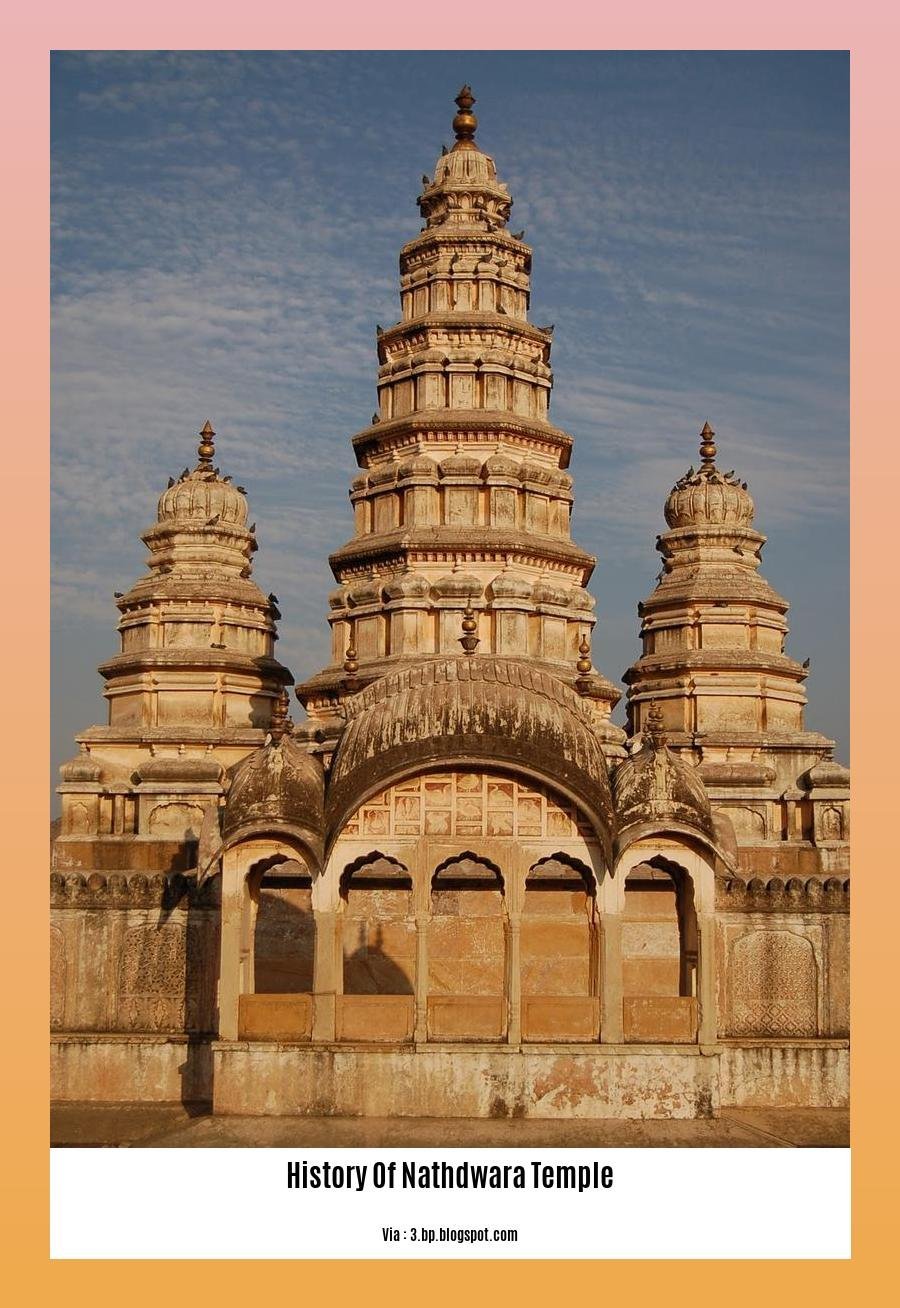Step into the enchanting world of Nathdwara Temple, a sacred pilgrimage site that has captivated hearts for centuries. Nestled in the heart of Rajasthan, India, this architectural marvel has witnessed the passage of time, playing a vital role in shaping the religious and cultural fabric of the region. Prepare to be enthralled by the captivating tale of its origins, the profound significance of its revered deities, and the architectural brilliance that has made it a timeless symbol of faith. Let us embark on an extraordinary journey through the annals of history, where the whispers of the past and the allure of the present intertwine to paint a captivating portrait of this beloved temple.

History of Nathdwara Temple: A Divine Odyssey
Imagine a tale of religious fervor and divine intervention that gave birth to one of India’s most revered temples. Let’s unravel the captivating history of Nathdwara Temple:
An Idol’s Journey:
Back in the 16th century, a sacred idol of Lord Krishna, known as Shrinathji, resided in the holy town of Vrindavan. However, when the wrath of the Mughal emperor Aurangzeb loomed upon the land, the priests guarding the idol were forced to embark on a daring mission to protect their beloved deity.
Under divine guidance, the priests carried the idol on a perilous journey, seeking refuge from the destruction that ravaged Vrindavan. They faced countless challenges along the way, but their faith never faltered.
A Divine Destination:
As if by divine decree, the priests were led to Nathdwara, a small village nestled on the banks of the Banas River. They believed that Lord Krishna himself had chosen this location as his eternal abode. The village derived its name “Nathdwara,” meaning “the gateway to the lord,” a testament to its profound significance as a pilgrimage destination.
The Sanctuary of Pushti Marg:
In 1672, under the patronage of the pious Goswami priests, the Nathdwara Temple emerged as a magnificent monument to Lord Krishna. It became the central shrine of the Pushti Marg, a Vaishnavite sect founded by the revered sage Vallabhacharya.
Vallabhacharya’s son, Vitthal Nathji, established the unique worship rituals and devotional practices that have come to define Nathdwara Temple’s legacy. The temple became a sanctuary for devotees, a place where they could immerse themselves in the divine presence of Shrinathji.
A Timeless Legacy:
Over the centuries, Nathdwara Temple has attracted countless pilgrims from across the country, earning its reputation as a sacred and revered destination. Its enduring legacy lies in the unwavering devotion of its followers, who continue to seek solace and inspiration within its hallowed walls.
The temple’s history is a testament to the enduring power of faith and the divine guidance that shapes the destinies of sacred places. It’s a story that continues to inspire and captivate hearts to this day.
The history of occupational therapist is a fascinating journey, showcasing the evolution of a profession dedicated to improving lives through meaningful activities. Additionally, explore the history of OSHA to understand the agency’s significant role in ensuring workplace safety and health standards.
Why do devotees flock to the Nathdwara Temple from across the globe?
Nestled in the heart of Rajasthan, the Nathdwara Temple is a spiritual magnet that draws devotees from far and wide. Its enchanting aura, steeped in history, mysticism, and devotion, makes it a sacred destination for pilgrims seeking solace and divine connection.
Lord Krishna’s Beloved Abode
At the core of Nathdwara’s allure lies the belief that Lord Krishna himself chose this serene spot as his eternal home. Legend whispers that as his idol journeyed from Vrindavan, the chariot carrying it mysteriously halted in Nathdwara, a divine sign that he had selected this sacred ground as his abode. Here, Lord Krishna is revered as Shrinathji, the adorable child form, and the temple serves as his earthly residence.
Lavish Shringar Rituals
One of the most captivating aspects of Nathdwara is the daily Shringar ritual, where devotees adorn the idol with intricate outfits and resplendent ornaments. The elaborate dressing showcases the boundless love and devotion of the faithful, transforming the idol into a living, breathing embodiment of the divine. Each day, Shrinathji emerges in a different attire, delighting visitors with a kaleidoscope of vibrant colors and exquisite craftsmanship.
Melodious Symphony of Devotion
The temple’s sacred precincts resound with the harmonious melodies of traditional instruments during festivals and special occasions. The rhythmic beat of drums, the sweet notes of flutes, and the melodious chanting of hymns create an enchanting atmosphere that elevates the spirits and heightens the devotional experience. The music reverberates through the air like a symphony of devotion, drawing pilgrims into a trance-like state of spiritual communion.
Key Highlights:
- Nathdwara Temple holds immense significance for followers of the Pushti Marg tradition, a sect of Vaishnavism.
- The temple’s enduring popularity is attributed to its association with Lord Krishna and the belief that he resides there permanently.
- The daily Shringar rituals are a mesmerizing display of love and dedication, adorned in an array of stunning outfits.
- The temple’s musical heritage contributes to its captivating atmosphere, creating a profound spiritual experience for devotees.
How does the temples iconography and rituals contribute to the popularity of Nathdwara Paintings?
Imagine a place where art and faith intertwine, a place where paintings come to life, inspired by the sacred spaces and rituals of an ancient temple. That place is Nathdwara, a town nestled in the heart of Rajasthan, India, where the Nathdwara Temple stands tall, a testament to the power of imagery and spirituality.
The temple is home to an exquisite collection of iconography, a visual language that tells the stories of Lord Krishna, the beloved deity worshipped here. These images, painted with intricate detail and vibrant colors, depict Krishna in various forms, each adorned with unique attire and ornaments. They capture the essence of the divine, inviting devotees into a realm of spiritual enchantment.
In the temple’s inner sanctum, daily rituals unfold, centered around the worship of Shrinathji, the presiding deity. The deity is adorned in elaborate outfits and jewelry throughout the day, reflecting the changing seasons and festivals. These rituals are a mesmerizing spectacle, witnessed by devotees with deep reverence.
It’s no wonder then that Nathdwara Paintings draw so heavily on the temple’s iconography and rituals. These paintings are like windows into the temple’s sacred spaces, capturing the essence of its imagery, its rituals, and the deep faith that resides within. They transport viewers to a world where the divine becomes tangible, where the stories of Lord Krishna come to life.
Key Takeaways:
- The temple’s iconography portrays Lord Krishna in various forms, inspiring the subjects of Nathdwara Paintings.
- Intricate mandalas and celestial figures from the temple’s walls find their way onto Nathdwara Paintings, creating a visual symphony.
- Daily rituals, such as “Shringar,” are depicted in Nathdwara Paintings, showcasing the intimate connection between devotees and Shrinathji.
Table: The Interplay of Temple Iconography and Rituals in Nathdwara Paintings
| Temple Iconography | Rituals | Contribution to Nathdwara Paintings |
|---|---|---|
| Intricate depictions of Lord Krishna | Daily worship of Shrinathji | Inspiration for the paintings’ subjects and styles |
| Mandalas, floral motifs, and celestial figures | Adornment of the deity | Creation of vibrant and visually stunning compositions |
| “Shringar” rituals, showcasing different outfits and ornaments | Devotional practices | Capture the intimate bond between devotees and the deity |
Conclusion:
The Nathdwara Temple is a living testament to the power of faith, a place where art and spirituality converge. The temple’s iconography and rituals have deeply influenced the popularity of Nathdwara Paintings, creating a unique artistic tradition that celebrates the divine and captivates the hearts of devotees worldwide.
What historical events led to the relocation of the idol of Lord Krishna to Nathdwara?
Picture this: the 17th century, a time when India was under the rule of the Mughal Empire. A time when their strict religious beliefs threatened to destroy Hindu temples. Among these temples, Vrindavan – the holy land of Lord Krishna – was in danger.
Imagine the fear that must have filled the hearts of devotees when they learned that their beloved Lord Krishna’s idol, Shrinathji, might be at risk. But in the face of this threat, a group of brave priests decided to do something extraordinary: they would protect Shrinathji.
They secretly took the idol away from Vrindavan, traveling in hiding until they reached Nathdwara – a peaceful town nestled by the Banas River. As they searched for a new home for Shrinathji, something amazing happened.
The chariot carrying the idol got stuck in the mud. Stuck so hard, they couldn’t even move it. It was like Lord Krishna himself was telling them, “This is where I want to stay.”
And so, in 1672, a beautiful temple was built right on the spot where the chariot got stuck. This temple became a haven for Shrinathji, a place where devotees could come and pray to him. And that’s how the idol of Lord Krishna found its final home in Nathdwara.
This story is a reminder of the power of faith and the ways in which people can defy the odds to protect what’s important to them. It also tells us about the journey of Shrinathji, a journey that ended in a place where he continues to be revered and worshipped by millions of pilgrims every year.
FAQ
Q1: When was the Nathdwara Temple built?
A1: The Nathdwara Temple was built in 1672 AD by Goswami priests.
Q2: Why was the idol of Lord Krishna transported to Nathdwara?
A2: The idol was moved from Vrindavan to Nathdwara to protect it from Mughal emperor Aurangzeb’s destruction of Hindu temples.
Q3: What is the significance of the term “Nathdwara”?
A3: “Nathdwara” translates to “gate of the lord,” referring to the temple’s dedication to Lord Krishna.
Q4: What distinguishes the Nathdwara Temple from other Vaishnavite shrines?
A4: The Nathdwara Temple is renowned for its exquisite Shringar rituals, where the idol of Shrinathji is adorned in different outfits daily.
Q5: What is the importance of the location chosen for the Nathdwara Temple?
A5: The temple’s location on the banks of the Banas River is believed to have been chosen by Lord Krishna himself when the chariot carrying his idol became stuck in the mud there.












